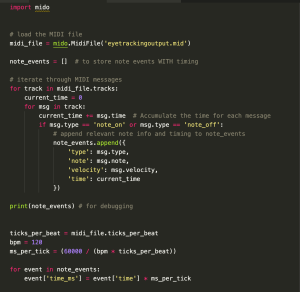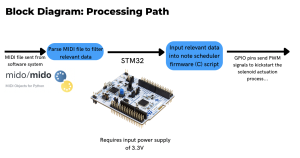As a team, we spent most of Week 7 working on our design report. This was a time intensive experience, as we had to do a lot of research, and discuss within our group facets of our design, testing and purpose, as well as how to convey all of that information efficiently and understandably in our report.
Because of this, our main risk right now is that we have fallen behind schedule. We had planned to have made further progress with the eye-tracking software and application at this point in the semester. However, we did allot weeks 12-14 and finals week for slack time, so we are hopeful that we have ample time to catch up and complete the tasks we have set for ourselves.
While working on the design report, we updated our Gantt chart, see below.
 Global Considerations, Written by Shravya
Global Considerations, Written by Shravya
Our solution goes beyond local or technological communities. Globally, there are millions of people living with disabilities (particularly, disabilities relating to hand/arm mobility) who may not have access to specialized instruments or music creation tools tailored to their specific needs. These people exist across various socio-economic and geographical (urban vs remote) contexts. Our solution offers a low-cost, technologically accessible means of composing and playing music, making it a viable option not just in academic or well-funded environments, but also in regions with limited access to specialized tools. By providing compatibility with widely used MIDI files, minimal physical set-up, and an eye-tracking interface we aim to make as user-intuitive as possible, users around the world will be able to express themselves musically without extensive training or high-end technology.
Cultural Considerations, Written by Fiona
Music is an important part of many cultural traditions. It is a tool for communication, and allows people to share stories and art across generations and between cultures. For example, many countries have national anthems that can be used to communicate what is important to that country. Broader access to music is thus important to many people, because it would allow them to participate in their culture or others, if they wished. Recognizing the importance of music for many individuals and groups, we hope that our project can be a stepping stone for more accessibility to musical cultural traditions.
Environmental Considerations, Written by Peter
By utilizing laptop hardware which is likely to already be owned by users, we are able to reduce the amount of electronic waste, which can be toxic and nonbiodegradable [1], that could be created by our product. Along with this, by working to minimize our products’ power consumption, we are minimizing our products’ contribution to pollution that results from non-renewable energy sources.
References
[1] Geneva Environment Network. (2024, October 9). The Growing Environmental Risks of E-Waste. Geneva Environment Network. https://www.genevaenvironmentnetwork.org/resources/updates/the-growing-environmental-risks-of-e-waste/




 Global Considerations, Written by Shravya
Global Considerations, Written by Shravya